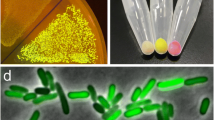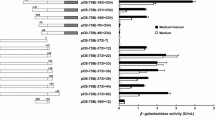Summary
The gene for chloramphenicol (Cm) acetyltransferase (CAT) carried by the staphylococcal plasmid pUB112, whose expression can be stimulated by Cm, is preceded by a regulatory region containing two control elements. One of these consists of a Shine-Dalgarno (SD) sequence followed by an open reading frame coding for a leader peptide of nine amino acids. Previous work has shown that the SD sequence is essential for inducibility of Cm resistance by the antibiotic (Brückner and Matzura 1985). Here we demonstrate that fusion of the leader peptide coding sequence to a truncated 'lacZ gene results in synthesis of a leader peptide-β-galactosidase fusion protein. Introduction of an ochre nonsense codon into the reading frame of the leader peptide sequence leads to considerable reduction of the basal expression and loss of inducibility of the cat gene. These results reveal that synthesis of the leader peptide is required for the basal and inducible expression of the cat gene and support the model of translational attenuation for its regulation.
Similar content being viewed by others
References
Ambulos NP, Mongkolsuk S, Kaufman JD, Lovett PS (1985) Chloramphenicol-induced translation of cat-86 mRNA requires two cis-acting regulatory regions. J Bacteriol 164:696–703
Bossi L (1985) Informational suppression. In: Scaife J, Leach D, Galizzi A (eds) Genetics of bacteria. Academic Press, pp 49–64
Brückner R (1986) Regulation des durch Chloramphenicol induzierbaren Chloramphenicol Acetyltransferasegens des Staphylococcus aurens Plasmids pUB112. Thesis, Heidelberg
Brückner R, Matzura H (1985) Regulation of the inducible chloramphenicol acetyltransferase gene of the Staphylococcus aureus plasmid pUB112. EMBO J 4:2295–2300
Brückner R, Zyprian E, Matzura H (1984) Expression of a chloramphenicol-resistance determinant carried on hybrid plasmids in Gram-positive and Gram-negative bacteria. Gene 32:151–160
Byeon WH, Weisblum B (1984) Post-transcriptional regulation of chloramphenicol-acetyl-transferase. J Bacteriol 158:543–550
Dekel-Gorodetsky L, Schoulaker-Schwarz R, Engelberg-Kulka H (1986) Escherichia coli tryptophan operon directs the in vivo synthesis of a leader peptide. J Bacteriol 165:1046–1048
Dubnau D (1984) Translational attenuation: The regulation of bacterial resistance to the macrolide-lincosamide-streptogramin B antibiotics. CRC Crit Rev Biochem 16:103–132
Dubnau D (1985) Induction of ermC requires translation of the leader peptide. EMBO J 4:533–537
Duvall EJ, Lovett PS (1986) Chloramphenicol induces translation of the mRNA for a chloramphenicol-resistance gene in Bacillus subtilis. Proc Natl Acad Sci USA 83:3939–3943
Duvall EJ, Williams DM, Lovett PS, Vasantha N, Guyer M (1983) Chloramphenicol-inducible gene expression in Bacillus subtilis. Gene 24:171–177
Kolter R, Yanofsky C (1982) Attenuation in aminoacid biosynthetic operons. Annu Rev Genet 16:113–134
Messing J (1983) New M13 vectors for cloning. Methods Enzymol 101:10–89
Miller JH (1972) Experiments in molecular genetics. Cold Spring Harbor Laboratory, Cold Spring Harbor, New York, USA
Sanger F, Nicklen S, Coulson AR (1977) DNA sequencing with chain-terminating inhibitors. Proc Natl Acad Sci USA 74:5463–5467
Shapira SK, Chou J, Richaud FV, Casabadan MJ (1983) New versatile plasmid vectors for expression of hybrid proteins coded by a cloned gene fused to lacZ gene sequences encoding enzymatically active carboxy-terminal portion of β-galactosidase. Gene 25:71–82
Shaw WV (1975) Chloramphenicol acetyltransferase from chloramphenicol-resistant bacteria. Methods Enzymol 43:737–755
Shaw WV (1983) Chloramphenicol acetyltranferase: enzymology and molecular biology. CRC Crit Rev Biochem 14:1–47
Silhavy TJ, Beckwith JR (1985) Uses of lac fusions to study the regulation of gene expression. Microbiol Rev 49:398–418
Towbin H, Staehelin Th, Gordon J (1979) Electrophoretic transfer of proteins from polyacrylamide gels to nitrocellulose sheets: Procedure and some applications. Proc Natl Acad Sci USA 76:4350–4353
Weisblum B (1983) Inducible resistance to macrolides, lincosamides, and streptogramin type-B antibiotics: The resistance phenotype, its biological diversity, and structural elements that regulate expression. In: Beckwith J, Davis J, Gallant JA (eds) Gene function in procaryotes. Cold Spring Harbor, New York, pp 91–121
Zahler SA, Korman RZ, Rosenthal R, Hemphill HE (1977) Bacillus subtilis bacteriophage SPβ: Localization of the prophage attachment site, and specialized transduction. J Bacteriol 129:556–558
Zoller MJ, Smith (1983) Oligonucleotide-directed mutagenesis of DNA fragments cloned into M13 vectors. Methods Enzymol 100:468–500
Zyprian E, Matzura H (1986) Characterization of signals promoting gene expression on the Staphylococcus aureus plasmid pUB110 and development of a Gram-positive expression vector system. DNA 5:219–225
Author information
Authors and Affiliations
Additional information
Communicated by A. Böck
Rights and permissions
About this article
Cite this article
Brückner, R., Dick, T. & Matzura, H. Dependence of expression of an inducible Staphylococcus aureus cat gene on the translation of its leader sequence. Mol Gen Genet 207, 486–491 (1987). https://doi.org/10.1007/BF00331619
Received:
Issue Date:
DOI: https://doi.org/10.1007/BF00331619




